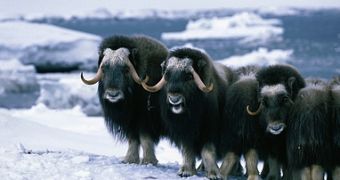This animal was the third largest beast that Europeans hunted when the continent was covered by ice and snow, after the woolly mammoth and woolly rhino. Indeed, the musk ox (Ovibos moschatus), even if not very tall due to its short feet (just 1.5 m or 5 ft), can be 410 kilos (910 pounds) heavy.
The lineage of the musk ox started 3-5 million years ago with an antelope from the Asian steppes, Boopsis. Numerous species of musk ox existed during the Ice Age in the Northern Hemisphere. One of them, Praeovibos priscus, had long twisted horns and lived in periglacial steppes in Eurasia, in a less harsh clime than the one preferred by the modern musk ox.
15,000-10,000 years ago, during the Ice Age the musk ox co-existed with Homo sapiens in Europe, being depicted in cave wall paintings and found amongst bones of the game hunted by the ancient humans in western Europe. With the retreat of the glaciers they went extinct in Eurasia. In the central Siberia they survived till 2,000 years ago. 90,000 years ago they had crossed from Siberia to Alaska, and from here to Canada and Greenland.
The name of "musk" comes from the fact the males have glands near the eyes having a smelly secretion resembling that produced by the musk deer. The secretion is abundant during the mating season and in case of danger. Despite their name, musk oxen are not related to cattle, but rather to sheep and goats.
Musk oxen live in herds of up to 100 individuals. Too old or too young males live in solitude or in groups of 2-7 individuals. During the mating season the bulls fight for females. They emit low moos, balance their heads (standing in front of each other) on the sides and from 12 m (40 ft) they run towards each other and clash (where the 10 cm (4 inch) thick horns attenuate the blow) and repeat this 'till one gives in. During the 5 weeks of mating season a bull can make 1,300 advances and copulate just 5 times!
If the herd is attacked by wolves, the adults form a circle isolating the calves. Wolves usually capture solitary males or ill individuals, or try to isolate calves. For defense, the oxen prefer terrains with less snow and their strikes are inscrutable.
The musk oxen eat dwarf willow, likens, sedges, fescues, mosses and other plants. In winter they eat dwarf willow, plants from the family of the cranberry, dry grass, likens. In winter they dig in the snow with the hoofs searching for food. The winters with deep snow are disastrous, as the animals cannot find food. In eastern Greenland, once at 15-16 years an ice crust covers the ground, leaving the oxen with no food at all.
Musk oxen make 30 km (19 mi) per week and in winter even more trying to find food rich areas (especially near rivers). They eat almost all day, with 2-3 hours daily reserved for ruminating. Musk oxen require dry areas (the calves are extremely sensitive to humidity) and attempts to introduce them in areas with high oceanic influences (like Svalbard or Iceland) failed. They cannot stand summer temperatures over 10-12' C either. Their southernmost area is in Thelon (western Hudson Bay) where the waters of the gulf cool down the clime.
The musk ox is adapted to nocturnal sight (due to the very long polar nights). Their eye sockets are prolonged being tube shaped and allowing them high visual acuity.
The wool retains the air, reducing the heat losses. If there are -26' C outside, inside the wool the temperature is 2' C. In fact, their wool isolates so well that the ice from their back does not melt from the heat of then body. A musk ox produces 2-3 kg (4.5-7 pounds) of wool annually, that's why there are attempts to tame the animal.
The massive shape and short ears, feet, neck and tail ensure a relatively small surface reducing the heat loss. Sweat glands are found only in the rear feet and this way they do not lose heat through sweating. During the tough winters, the dominant males impede young and pregnant cows to feed correctly, which results in abortions and a lowered survival rate of the young as well as a decreased number of births next spring. If food is abundant, they all feed normally and many survive the winter, while cows deliver a lot of calves.
The gut bacteria recycle the nitrogen from the food of the musk oxen, that's why they do not eliminate it through urine like in the case of other herbivorous species. Today, musk oxen are encountered in northern and eastern Greenland, the arctic Canadian islands (except Baffin), and mainland northwestern Canada. They have been introduced in northern Alaska, Norway, southwestern Greenland, Taimir peninsula (northern Siberia).

 14 DAY TRIAL //
14 DAY TRIAL //